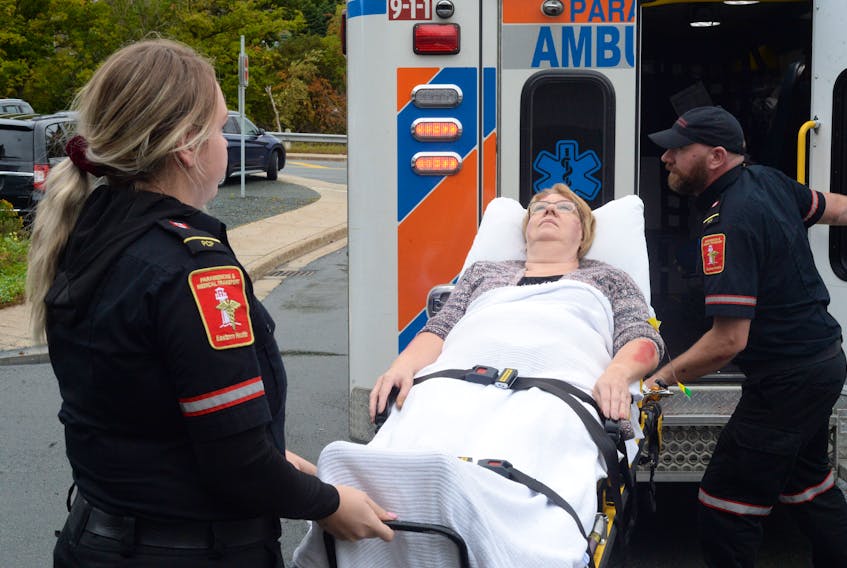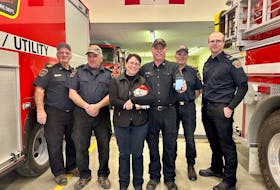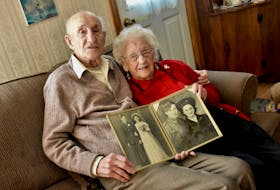ST. JOHN'S, N.L. — It was a mock exercise — a fake Code Orange meant to test emergency response at the Health Sciences Centre in St. John’s, but it took place against a backdrop of a very real circumstance: a bottlenecked emergency room.
“This morning I was part of one of the two crews called in to attend and participate in the Code Orange simulation at the Health Sciences and Janeway ERs,” a paramedic wrote to Eastern Health’s metro paramedicine management on Oct. 16. The person acknowledged the importance of training exercises, but also expressed concerns about “overworked resources, and lack thereof.”
More than 50 fake patients were distributed to what the paramedic described as an empty Janeway ER. But over at the Health Sciences Centre (HSC), the emergency room (ER) was over capacity with real patients, and by the end of the mock-drama had become double over capacity with actual sick people.
“There was a time during the offload that a ‘fake patient’ had to get up off a stretcher in the hallway to place a real one there. The ER had up-staffed, as did our department to meet the needs for the planned simulation,” reads the email, contained in a nearly 500-page response from Eastern Health to a Telegram access to information request regarding paramedic concerns. (Much of that document was repeated emails with some media coverage scans.)

The paramedic writing the email said they left the mock exercise feeling somewhat frustrated.
The email describes a followup gathering in the main auditorium of the hospital complex, where most of the feedback on the exercise from participants was positive.
The paramedics standing at the back, however, were asked their opinion. That portion of the email — documenting their feedback — was redacted.
The paramedic was told by management that the email had made many good points, and acknowledged the day shift is a flat-out buzz of activity due to call volumes and transfers.
“Everyone, your emails are not falling on deaf ears,” paramedicine management replied to the email.
“We certainly recognize the pressures you are all under and are trying our best to resolve the bigger issue.”
Another portion of the email thread portrayed a particular shift in which there were five calls stalled in the medical communications centre queue. Those calls seemed to be of lower priority, including transfers back to residences because stretchers were required. Nevertheless, it indicated stress on the system.
“I granted special permission to go down to two emergency crews available to get these patients out in hopes of getting four beds free throughout the hospital and four patients off our stretchers in the ER hallway,” wrote the management email.
“I had already approved two extra crews to be called in as needed and we had one extra crew in and sent to Burin. Believe me, your management team knows exactly what is happening out there and the workload demands. … The managers are also stretched to a thin line every day as well.”

Another email to paramedicine management on Oct. 15 had the subject line “busy (shift changes)."
“Just starting shift, and already chaotic — for the second night in a row. Last night was unbelievably busy with no breaks until halfway through the shift. We began tonight with four units on OLD (offload delay — in which paramedic crews must remain with their patients at the ER until they are handed off to hospital staff), a possible cardiac arrest at (long-term care home) St. Luke’s, an airway obstruction at (long-term care home) St. Pat’s — all before 8 p.m.
"With crews switching out from days to nights, crews having to piece together units to use, air ambulance dealing with various issues — which leaves the (medical communications operator) in the position of having to completely change gears and answer other unrelated calls, numerous out-of-town emergency calls through the RCMP — proving to be a very challenging start to the shift. It’s almost impossible at times to effectively maintain the (system status plan, in which units are located in ambulance stations and on standby at specific areas in metro). Crews are getting halfway to location and being pulled out to cover elsewhere or respond to a call.”
The email writer spoke of the medical communications centre fielding calls from crews on offload delays who want to go home, technical glitches staff have become accustomed to and having to open four or five screens to construct the next day’s roster “and “hoping I don’t make any mistakes while minimizing it several times to answer the phone,” as well as periods when there is “absolutely no supervision."
“Shift change continues to be a challenge for all involved,” wrote the staffer, whose title was redacted.
Another October email sheds light on an apparent internal miscommunication of policy that left a paramedic crew on offload delay for 40 minutes.
Apparently, when the crew contacted dispatch because their patient had not been triaged, dispatch was told by management that if an ER charge nurse has been informed of a “chief complaint,” such as the patient has hip pain, it is considered a “mini triage” and that’s sufficient for the charge nurse to acknowledge and change the patient flow as required.

In a November interview with The Telegram related to ongoing issues raised by paramedics about offload delays, Michelle Breen, Eastern Health's regional director of paramedicine and medical transport, said offload delays have skyrocketed in just a few years, going from roughly 15 minutes to several hours.
To try to combat it, Eastern Health has had paramedic teams buddy up on low-acuity (least sick/at-risk) patients — one paramedic team can wait with three of those patients while the other ambulances get back on the road. Casuals can also be called in to free up ambulances, and routine transfers can be delayed.
To try to ease workload and frustration, Eastern Health has also tweaked shifts to match peak volume times, and readjusted since then to allow paramedics to restock their vehicles and file their paperwork at the end of their 12-hour rotation, based on some of the concerns that have been recently raised.
RELATED









